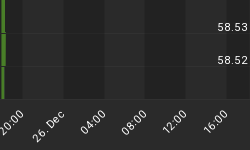
![]() Larger Image - Charts created using Omega TradeStation 2000i. Chart data supplied by Dial Data
Larger Image - Charts created using Omega TradeStation 2000i. Chart data supplied by Dial Data
The Dow Jones Industrials (DJI) has crossed into record (nominal) territory when it closed over the October 9, 2007 high. Halleluiah! It only took five years and four months plus 24 days for the market to break even. Not bad for an economy that is barely growing (supposedly forecasted at 2.2% GDP growth in 2012 but Q4 was an anaemic 0.1% giving rise to potential 2012 growth being only 1.5%).
China, on the other hand continues to show considerable growth albeit a slower rate from the heady days when GDP growth regularly exceeded 10%. China's GDP growth in 2012 is forecasted to be 7.8%. Yet their stock market is nowhere near its all-time high seen back on October 31, 2007. The Chinese stock exchange as represented above by the iShares FTSE China 25 Index Fund (FXI-NYSE) remains down 44% from its all-time high. Not only is the FXI down from its all-time high the FXI is falling from a recent high down about 10% thus far in 2013.
It's not as if the Chinese aren't pumping their money supply just as the US is doing. China has its own form of QE and a massive infrastructure-spending program as well. Some of that infrastructure it appears was real estate. Specifically they have built entire cities - with no one in them.
On March 3, 2013, CBS news magazine 60 Minutes broadcast two segments dealing with real estate in China. One segment featured the rise of a female billionaire Zhang Xin. Her interview was engaging and interesting. The second segment was what one would call a "jaw dropper". According to the segment, China may have created the largest housing bubble in human history. They have built cities, communities and more with - no one in them. They are called "ghost cities".
The segments can be seen here. http://www.cbsnews.com/video/watch/?id=50142079n.
Property values it seems have doubled, tripled and more. But it is not end buyers. They are being purchased for investment purposes. Apparently, between 12 and 24 cities are built each year. And this infrastructure just sits there empty. As the 60 Minutes says, it is bizarre, surreal. Most people cannot afford the housing. Seems only the investors can. For the moment at least. Until all of this evaporates.
China is trying to prick the bubble but it is not easy. Investor's will lose fortunes, property developers will go bankrupt and thousands of workers would be unemployed. That in turn could lead to social unrest.
So is the Chinese stock market spotting the growing trouble? After all, the housing market blew up the Euro zone and the US.
The FXI is forming a large symmetrical triangle. Symmetrical triangles can either be a consolidation pattern or a topping pattern and even sometimes a bottom pattern. Key obviously is which way the triangle breaks. A break to the upside could have objectives up to $61. However, a break to the downside could see the FXI collapse to $14. That would be below the 2008 lows of $19.35.
But what about the US market? Well it has been "on a roll" with the DJI making new all-time (nominal) highs and the S&P 500 just below its 2007 highs. The weekly chart of the S&P 500 is flashing "trouble" even as it moves higher. Numerous weekly indicators are flashing warning signs with negative divergences. There is non-confirmation with fewer new highs. The S&P 500 appears to be forming a huge upward ascending wedge triangle. However, there is still room to move to the upside that could see the S&P 500 rise towards 1,600 (and a long held objective at 1,605).
So what has been pushing the US indices higher? Well the economy appears to be growing. Although one would never know it from the Q4 GDP. Retail sales are anaemic. Wal-Mart was calling February sales "a disaster". The housing market is buoyant. Or is it? Yes, housing sales have been improving and there are renewed signs of houses being built.
But peel back the numbers and one discovers that housing sales are been driven primarily by investors not end buyers. Personal income has been falling while personal spending has been rising suggesting that the consumer is digging into his credit cards once again. Median income has been falling for a decade. Many potential homebuyers no longer qualify for a mortgage. This is a problem for the banks as there is a dearth of borrowers. Where are the sub-prime loans when one needs them? That is what got the markets into trouble in the first place.

![]() Larger Image - Charts created using Omega TradeStation 2000i. Chart data supplied by Dial Data
Larger Image - Charts created using Omega TradeStation 2000i. Chart data supplied by Dial Data
The Chinese market could be living on borrowed time. When the Chinese real estate bubble bursts, it could take the US market down with it. On the other hand, Chinese authorities have, it seems, ways of papering over the problems. There are many people in China that need housing. The question is how to get them the income or the funds so that they can move into these "ghost cities". In the interim, it could turn out to be "caveat emptor".
















